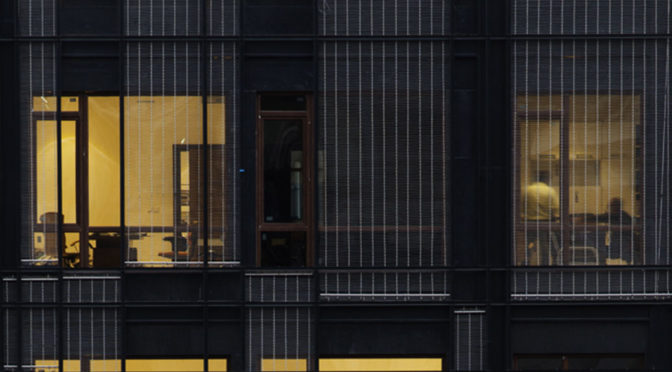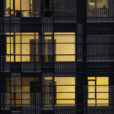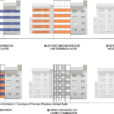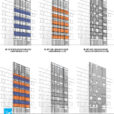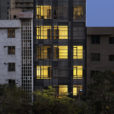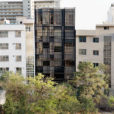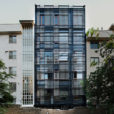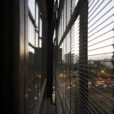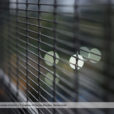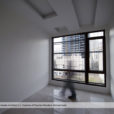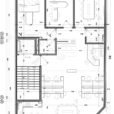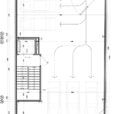ساختمان اداری نارنجستان
پیمان میدانی، بهزاد آیتی
فینالیست سومین دوره جایزه شایستگی معمار ایرانی (۱۳۹۹)
موقعیت: تهران، ایران
تاریخ: ۱۳۹۳
مساحت: ۱۰۴۴ مترمربع
وضعیت: ساختهشده
کارفرما: محمدرضا آیتی
تیم پروژه: پریهان رشیدی، محسن حقپرست، محبوبه یوسفیخواه، اندیشه غفرانی
عکس: مرجان یزدی
ساختمان نارنجستان، واقع در کوچه نارنجستان سوم، در طرف نزدیکتر به خیابان پاسداران، یکی از چندین بلوک ساختمانی در یک ردیف خطی، بدون عقب و جلو رفتن است. در این کوچه، طبق ضوابط شهرداری، به دلیل عرض کم، رعایت عدم پیشآمدگی بنا الزامی بوده است. طراحی نما به نحوی که در عین پاسخگویی به نیازهای ساختمان، بافت شهری را دچار آشفتگی نکند، همواره دغدغه بسیاری از معماران و شهرسازان بوده و هست. در ساختمان نارنجستان، با توجه به کمبودن بَر ساختمان و خواسته کارفرما مبنی بر استفاده حداکثری از مساحت، به اوج این چالش رسیدیم، به طوری که طراحی نما در قالب یک صفحه، بدون بازی حجمی، در واقع، طراحی بخشی از یک نمای یکپارچه به طول کوچه و ارتفاع ساختمانها بود. در عین حال، بر آن شدیم تا به غیر از رعایت عدم ایجاد آشفتگی در نمای شهری، این ساختمان را محل وحدت ناهماهنگیهای بافت اطرافش قرار دهیم.
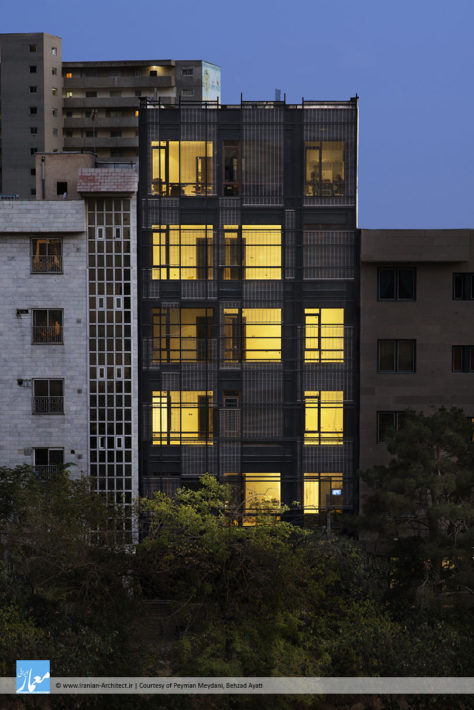
ساختمان نارنجستان در کوچهای هشتمتری واقع است که انواع سبکهای اجرایی و گوناگونی مصالح در بلوکهایی با بَر بسیار کم، باعث شده تا در آن آشفتگی بسیاری احساس شود. بنابراین، رسالت شهری این ساختمان، نوعی همنوازی با نواختههای بینظم اطراف و ایجاد ارتباط بین ریتم نُتهای بیربط شهری است. همنوازی در بین این آشوب، نه سکون است، نه سکوت، چرا که اینها خود حرفی جدید در این پهنه هستند. به دلیل تلاشی که برای حفظ سازه پروژه کردیم، به عنصری نیاز داشتیم تا در نقش واسطی هماهنگ با فضای اطراف و نیازهای داخلی پروژه عمل کند. تنها جواب مناسب این نیاز، پوستهای بر روی نماست؛ این پوسته شامل شبکهای است که از خطوط گرفتهشده از ساختمانهای اطراف خلق شده است. در نتیجه، نمای ساختمان، خود وامدار نماهای اطراف و محل تعدیل خطوط آنها، با توجه به خطوط پدیدآمده از رفع نیاز ساختمان است.
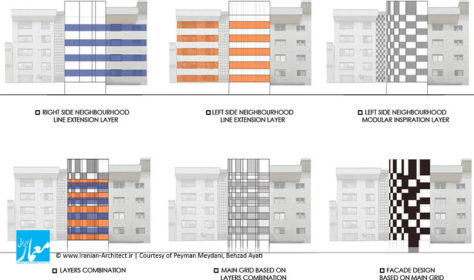
در واقع، طراحی نهایی نما حاصل برهمکنش سه لایه است: لایه اول و دوم، امتداد خطوط ساختمانهای دو طرف و لایه سوم، ریزشدن مدول شبکه نما، متاثر از نمای ساختمان سمت چپ است. از روی هم قرار گرفتن این سه لایه، شبکهای منتج میشود که حاوی ساختاری است که بر اساس ساختمانهای اطراف شکل میگیرد. عینیشدن این نما نیز در آخر، مدیون استفاده از متریالهای شفاف و نیمهشفافی بود که در پروژه دیدیم و با توجه به کاربری اداری پروژه، در این راستا نیز مفید فایده بود. در نهایت، حاصل تلاشمان، نمایی متشکل از یک پوسته بود که نه فقط محل آرامشی در ناآرامیهای شهری که آرامشدهنده و هماهنگکننده نماهای اطراف نیز شد.
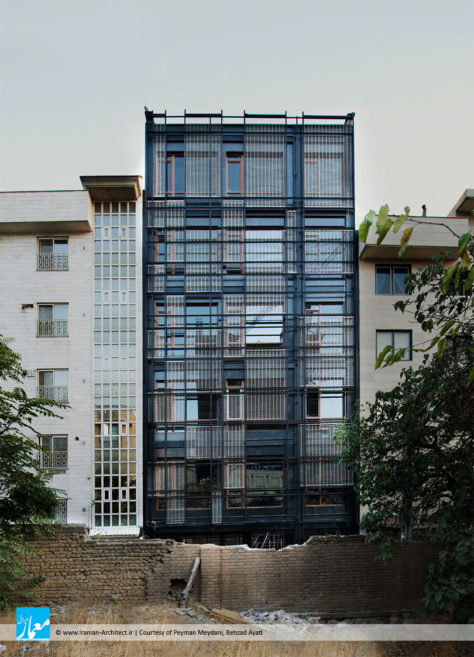
ساختمان نارنجستان، شامل ۵ طبقه اداری و یک طبقه پارکینگ در تراز همکف و یک طبقه زیرزمین، شامل آمفیتئاتر و انباری، است. سیستم تاسیساتی ساختمان، وی آر اف، و سازه بنا، اسکلت فلزی است.
Narenjestan Office Building
Peyman Meydani, Behzad Ayati
Finalist of Iranian Architect Merit Award 2020
Location: Tehran, Iran
Date: 2014
Area: 1,044 sqm
Status: Completed
Client: Mohammadreza Ayati
Project Team: Parihan Rashidi, Mohsen Haghparast, Mahboubeh Yousefikhah, Andisheh Ghofrani
Photo: Marjan Yazdi
Located in 3rd Narenjestan alley, near Pasdaran Street, Narenjestan building belongs to one of those blocks which stands in a straight line, without any back or front strain. According to municipal lows and narrow width of allay, no strain was an obligation. Producing a responsive façade to the building requirements which simultaneously does not disturb the urban context, is always one of architect’s goals. In Narenjestan project, architect has a challenge; while the width of building is not eye catching, the client wants the maximum usage of building area; so, there is not any opportunity to build a façade with any solid combination; thus the exterior face of building is a part of flat surface, with the length of allay and height of surrounding buildings. Observing no written role of façade designing, not to produce any chaos in urban context, the architect decided to put this project a place of unifying the surrounded inconsistency.
Narenjestan building is located in 8 meters width alley, with a combination of various type of design with lots of materials and construction methods which resulted in situation that is called chaos. Preparing a harmony between the different types of orders and styles around the building is the main idea of design. Playing among the different notes is neither silence nor inactivity, because the new playing is a new music in this area, because of the architect’s efforts to preserve the structure of building it is needed to use a material which acts like a medium to harmonize the project necessities and neighboring buildings. From the architect’s perspective, the only response is a surface which stretches in the outer face of building. The horizontal and vertical elements of the façade are coming from the main linear elements of neighboring buildings. As a result, the surface is indebted of the context and it is a place to moderate the linear combination of surrounding area and the requirements of the building.
The façade has been produced from the interaction of three layers, two layers from the each of surrounding context and the third from the building itself. Realization of this concept is achieved by the usage of transparent and semitransparent materials. Combining the three mentioned layers, the façade organization is produced like a chess board net which is rescaled in some units according to the neighboring context. Finally, the design efforts leads the architect to a semitransparent surface which not only is a kind of repose place but also coordinates the surrounding context.
Narenjestan building is designed in 7 floors; containing five official floors, one parking floor and gathering saloon plus storages which are located in the underground floor. Project benefits from the steel structure system and VRF utility system.

